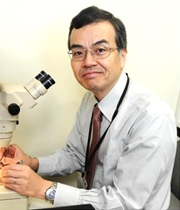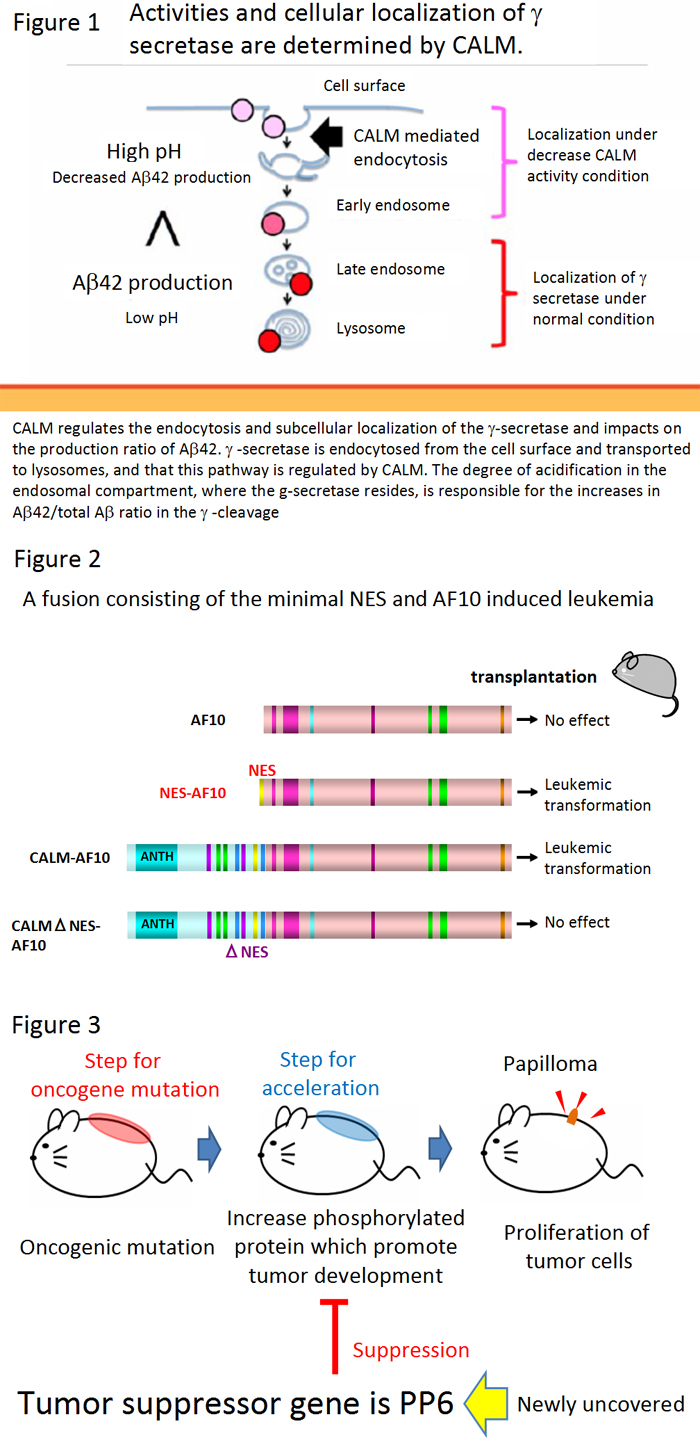Searching for "the True Functions of Genes," that Can Only be Known After Removing the Action of One Gene
- From Fundamental Biology to Understanding the Causes of Human Disease -
 [Release: August, 2015]
[Release: August, 2015]
Professor Toshio Watanabe
Biological Sciences Course
Department of Chemistry, Biology, and Environmental Science
Faculty of Science
Nara Women's University
In the Watanabe Research Laboratory, we create gene knockout mice to study what occurs at the cellular and organismal levels when one gene is lost. Using such mice, we perform research related to basic gene functions and the diseases that are caused by a functional abnormality. For our research targets, we select genes that are thought to be related to intracellular distribution and transport, and that are suspected of being related to human diseases. Here, I introduce three areas of research that have clarified relationships to human diseases and that have recently been published.
(1) Functional Suppression of CALM May Be a Predictor of Alzheimer's Disease
Research Background:
Based on large-scale genome analysis, it was hypothesized that CALM, a collection of molecules used as a transport container during intracellular distribution and transport, was related to Alzheimer's disease. However, until now, there had been no research on whether these proteins are a risk factor, or how they contribute to disease.
Research Results and Significance:
In joint research with the Tokyo University School of Pharmaceutical Sciences, we discovered that suppressing CALM reduces the generation of amyloid ß protein, which is the causative substance in Alzheimer's disease (Fig. 1). This is the first study that has experimentally verified this action of CALM, both at the cell level and at the organism level. Clarifying the pathogenesis of Alzheimer's disease via CALM is expected to contribute to the development of new drugs in the future. Mai Suzuki, a student at Nara Women's University, participated in this research. This research has received assistance from a grant-in-aid for scientific research from the Ministry of Education, Culture, Sports, Science, and Technology (MEXT), and as a funded project of the Nara Women's University. The results of this research were published in Nature Communications in 2014 and Human Molecular Genetics in 2016.
(2) Epigenetic Factor AF10 Causes Leukemia by Fusing with CALM's Nuclear Export Signal Sequence
Research Background:
It was previously shown that AF10 fuses with CALM to form CALM-AF10, and this causes leukemia. However, it is completely unknown as to why fusion with CALM is necessary.
Research Results and Significance:
In a joint research with Japan's National Cancer Center Research Institute, from a functional analysis of the CALM molecule, it was discovered that fusion of AF10 with the nuclear export signal (NES) sequence of CALM causes leukemia (this is a completely new mechanism for leukemia pathogenesis) (Fig. 2). This discovery is expected to contribute to the development of new treatment drugs directed at inhibiting the function of the nuclear export signal mechanism. Mai Suzuki, a student at Nara Women's University, participated in this research. This research has received assistance from a grant-in-aid for scientific research from the Ministry of Education, Culture, Sports, Science, and Technology (MEXT), and as a funded project of the Nara Women's University. The results of this research were published in Cancer Science in 2014.
(3) Clarification of a Mechanism for Repressing Skin Cancer, which was not Previously Understood
Research Background:
Skin cancer arises through two steps: a mutation in an oncogene and tumor development. From a large-scale genetic analysis, attention was first drawn to the loss of activity of the phosphatase PP6 as a candidate factor for promoting tumor development, but this had not been verified. It was also said that PP6 was related to the function of Golgi bodies, which are the distribution centers for intracellular distribution and transport.
Research Results and Significance:
In joint research with the research lab of the Miyagi Cancer Center, we clarified that cancer occurs when PP6 is lacking, even if there is no other agent present that promotes tumor development. This has shown for the first time that PP6 is a tumor suppressor gene that acts as a brake to inhibit skin cancer development (Fig. 3). This discovery is expected to contribute to the development of new drugs for cancer prevention and treatment, directed at promoting phosphatase activity, and also to contribute to cancer diagnosis.
Honami Ogoh Ayako Kishimoto, and Mai Suzuki, students at Nara Women's University, participated in this research.
This research has received assistance from a grant-in-aid for scientific research from the Ministry of Education, Culture, Sports, Science, and Technology (MEXT), and as a funded project of the Nara Women's University. The results of this research were pre-published in the online edition of Oncogene and Cancer Letters in 2015.

Recent Publications Related to this Research
1) Kunihiko Kanatsu, Yuichi Morohashi, Mai Suzuki, Toshio Watanabe, Taisuke Tomita and Takeshi Iwatsubo. (2014)
Decreased CALM expression reduces Ab42 to total Ab ratio through clathrin-mediated endocytosis of g-secretase.
Nature Communication , DOI: 10.1038/ncomms4386.
http://www.readcube.com/articles/10.1038/ncomms4386
2) Kunihiko Kanatsu, Yukiko Hori, Sho Takatori, Toshio Watanabe, Takeshi Iwatsubo, and Taisuke Tomita. (2016)
Partial loss of CALM function affects g-secretase-mediated Ab42 production and amyloid deposition in vivo.
Human Molecular Genetics, in press.
http://hmg.oxfordjournals.org/content/early/2016/07/20/...
3) Mai Suzuki, Kazutsune Yamagata, Mika Shino, Yukiko Aikawa, Koichi Akashi, Toshio Watanabe and Issay Kitabayashi. (2014)
Nuclear export signal within CALM is necessary for CALM-AF10-induced leukemia.
Cancer Science, 105, 315-323.
http://onlinelibrary.wiley.com/doi/10.1111/cas.12347/abstract...
http://www.ncbi.nlm.nih.gov/pmc/articles/PMC4317939/
4) Katsuhisa Hayashi, Yuki Momoi, Nobuhiro Tanuma, Ayako Kishimoto, Honami Ogoh, Hiroyuki Kato, Mai Suzuki, Yoshimi Sakamoto, Yui Inoue, Miyuki Nomura, Hiroshi Kiyonari, Masato Sakayori, Kayoko Fukamachi, Yoichiro Kakugawa, Yoji Yamashita, Shigemi Ito, Ikuro Sato, Akira Suzuki, Miki Nishio, Masami Suganuma, Toshio Watanabe and Hiroshi Shima. (2015)
Abrogation of protein phosphatase 6 promotes skin carcinogenesis induced by DMBA.
Oncogene 34, 4647-4655.
http://www.nature.com/onc/journal/v34/n35/full/onc2014398a.html
http://www.ncbi.nlm.nih.gov/pubmed/25486434
5) Hiroyuki Kato, Nobuhiro Tanuma, Katsuhisa Hayashi, Koreyuki Kurosawa, Yuki Momoi, Honami Ogoh, Masato Sakayori, Yoichiro Kakugawa, Yoji Yamashita, Koh Miura, Shigemi Ito, Ikuro Sato, Natsuko Chiba, Toshio Watanabe and Hiroshi Shima. (2015)
Loss of Protein phosphatase 6 in mouse keratinocytes increases susceptibility to ultraviolet-B-induced carcinogenesis.
Cancer Letters, 365, 223-228.
http://www.sciencedirect.com/science/article/pii/S0304383515003729

